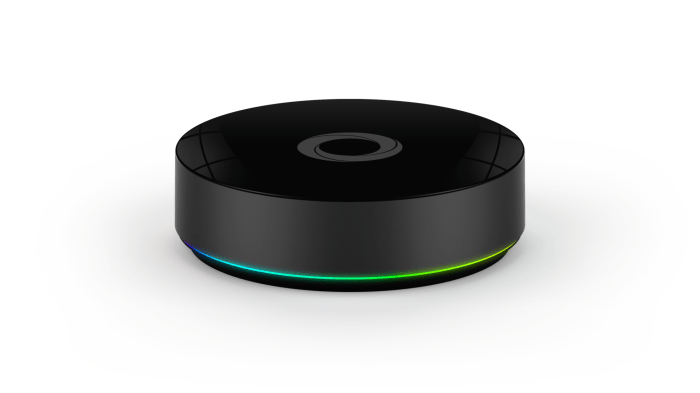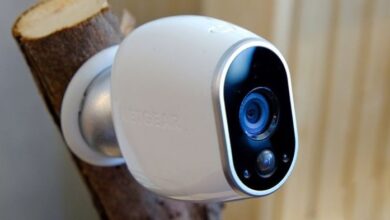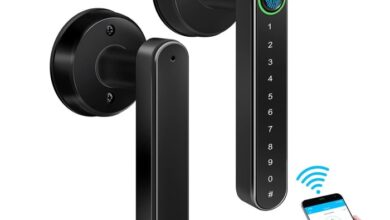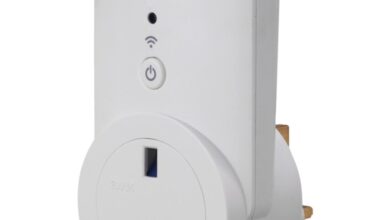Smart Home Hub Your Connected Home Awaits
Smart Home Hubs: Imagine a home that anticipates your needs, reacting seamlessly to your preferences. This isn’t science fiction; it’s the reality smart home hubs deliver. From effortlessly controlling your lights to securing your property with integrated security systems, these central command centers are revolutionizing how we live. This deep dive explores the world of smart home hubs, uncovering their capabilities, integrations, security aspects, and the exciting future they promise.
We’ll dissect the various types of hubs available, comparing leading brands and their functionalities. We’ll unravel the complexities of smart home protocols, guiding you through the seamless (or sometimes bumpy!) process of integrating your devices. We’ll also address crucial security and privacy concerns, offering practical tips to safeguard your connected home. Ultimately, this exploration aims to empower you to make informed decisions and unlock the full potential of your smart home journey.
Defining Smart Home Hubs
Smart home hubs are the central nervous system of your connected home, acting as the communication bridge between your various smart devices. They simplify the management of your smart home ecosystem, allowing you to control everything from lighting and temperature to security systems and entertainment, all from a single, convenient interface. This consolidation not only streamlines control but also enhances efficiency and improves the overall user experience.
Without a hub, managing multiple smart devices can become a complex and frustrating task.Smart home hubs achieve this through various communication protocols, enabling them to interact with a wide range of devices from different manufacturers. This interoperability is a key advantage, allowing you to build a truly integrated smart home environment regardless of the individual brands of your appliances.
They act as translators, ensuring seamless communication between devices that might otherwise be incompatible. This is crucial for a truly integrated and user-friendly smart home.
Types of Smart Home Hubs
The market offers a variety of smart home hubs, each with its own strengths and weaknesses. The most common types include those based on specific operating systems or platforms. Some hubs are designed to work primarily with devices from a single ecosystem, while others offer broader compatibility. Understanding these differences is crucial for choosing the right hub for your needs and existing smart home setup.
The choice often depends on your preferred smart home ecosystem, existing devices, and desired level of control and integration.
Comparison of Leading Smart Home Hub Brands
Several leading brands dominate the smart home hub market, each offering unique features and capabilities. Direct comparisons highlight the key differences in functionality, compatibility, and overall user experience. These differences extend to factors like voice assistant integration, app features, and the range of supported smart home devices. A thorough evaluation of these aspects helps consumers make informed purchasing decisions.
| Brand | Key Features | Compatible Devices/Protocols | Price Range |
|---|---|---|---|
| Amazon Echo (with Alexa) | Voice control, music streaming, smart home device control, skill integration | Alexa-compatible devices, Zigbee, Z-Wave, Bluetooth | $50 – $200 |
| Google Home (with Google Assistant) | Voice control, Google services integration, smart home device control, Chromecast support | Google Assistant-compatible devices, Thread, Zigbee, Z-Wave, Bluetooth | $50 – $300 |
| Apple HomePod (with Siri) | Voice control, Apple Music integration, seamless integration with Apple devices, HomeKit support | HomeKit-compatible devices, Bluetooth | $300 – $400 |
| Samsung SmartThings Hub | Smart home device control, Z-Wave and Zigbee support, energy monitoring capabilities, robust automation features | SmartThings-compatible devices, Z-Wave, Zigbee | $70 – $150 |
The price range reflects the varying capabilities and features offered by each hub. For example, hubs with more advanced features, wider compatibility, and better performance often come at a higher price point. However, even entry-level hubs offer significant value for users looking to simplify their smart home management. The best choice depends on individual needs and budget considerations.
Consider factors like the number of devices you own, the types of devices you use, and your preferred voice assistant.
Smart Home Hub Integrations
The ability to seamlessly connect various smart devices within your home is the cornerstone of a truly effective smart home system. A smart home hub acts as the central nervous system, orchestrating communication between seemingly disparate devices and services. Understanding the underlying technologies and potential challenges involved is key to maximizing the benefits of this increasingly popular technology. This section delves into the intricacies of smart home hub integrations, exploring the protocols, processes, and potential pitfalls.Smart home hubs rely on a variety of communication protocols to connect with different devices.
The success of any integration hinges on the compatibility between the hub and the individual devices. This compatibility is often determined by the specific protocols each device supports. A thorough understanding of these protocols is crucial for troubleshooting and ensuring a smooth, integrated smart home experience.
Smart Home Protocols and Hub Compatibility
Different smart home devices use various communication protocols, creating a complex landscape for integration. Zigbee, Z-Wave, Wi-Fi, Bluetooth, and Thread are among the most prevalent. Zigbee and Z-Wave are low-power, mesh networking protocols ideal for battery-powered devices, offering robust range and reliability. Wi-Fi is ubiquitous but more power-hungry. Bluetooth excels in short-range, low-latency applications, while Thread is a newer protocol designed for low-power, mesh networking with enhanced security.
A hub’s compatibility with these protocols directly impacts the range of devices it can control. For instance, a hub supporting only Wi-Fi will be limited to Wi-Fi-enabled devices, while a hub supporting multiple protocols offers broader integration capabilities. The selection of a hub should be driven by the specific devices you intend to integrate and the protocols they use.
This ensures optimal functionality and minimizes compatibility issues.
Integrating Smart Devices with a Smart Home Hub
The process of integrating a smart device typically involves downloading the manufacturer’s app, creating an account, adding the device to the network, and then linking it to your smart home hub through the hub’s app. Most hubs provide clear, step-by-step instructions within their applications, guiding users through the process. However, complications can arise, particularly when dealing with devices from different manufacturers that use incompatible protocols.
The hub’s ability to act as a translator between these different protocols is paramount to a successful integration. For instance, if a hub supports both Zigbee and Z-Wave, it can bridge the communication gap between devices using these different protocols, creating a unified smart home experience. This often requires the hub to perform protocol translation and data formatting, which adds a layer of complexity to the integration process.
Challenges in Integrating Smart Devices from Various Manufacturers
Integrating devices from diverse manufacturers presents several challenges. Incompatibility between different protocols is a primary hurdle. Even if a hub supports multiple protocols, there might be inconsistencies in how those protocols are implemented by different manufacturers, leading to integration failures. Furthermore, some manufacturers use proprietary protocols or APIs, making integration with third-party hubs difficult or impossible. Security concerns also play a significant role.
Ensuring that all devices communicate securely within the smart home network is crucial to prevent vulnerabilities and protect user data. A well-designed hub should incorporate robust security measures to mitigate these risks. Finally, the user interface can significantly impact the ease of integration. A poorly designed app can make the process confusing and frustrating, even for technically savvy users.
Examples of Common Smart Home Devices and Their Functionalities
The range of smart home devices that can be integrated with a hub is vast and continually expanding.
- Smart Lighting: These devices offer features like dimming, color changing, scheduling, and remote control, enhancing convenience and energy efficiency. Imagine setting the lights to turn on automatically at sunset, creating a welcoming atmosphere.
- Smart Thermostats: These programmable thermostats learn your preferences and optimize heating and cooling schedules to save energy and improve comfort. For example, they can automatically lower the temperature when you are away and raise it before you arrive home.
- Smart Locks: These enhance home security by providing remote access control, keyless entry, and activity monitoring. You can unlock your door remotely, grant temporary access to guests, and receive notifications when someone enters your home.
- Smart Speakers: These serve as central control points for your smart home, allowing voice control of various devices and access to information and entertainment. Simply ask your speaker to turn off the lights or play your favorite music.
- Smart Plugs: These allow you to control the power to any appliance remotely, offering convenience and energy management features. Turn off electronics that are not in use to reduce energy consumption.
Smart Home Hub Security and Privacy
The convenience and automation offered by smart home hubs come with inherent security and privacy risks. Understanding these risks and implementing robust security measures is crucial for protecting your home and personal data. This section delves into best practices, security features, privacy implications, and potential vulnerabilities to help you navigate the complexities of a secure smart home ecosystem.
Securing Smart Home Networks
A strong, secure network foundation is paramount. This involves using a robust and unique password for your Wi-Fi router, enabling WPA2/WPA3 encryption, and regularly updating your router’s firmware. Consider isolating your smart home devices onto a separate network segment (using a VLAN, for instance) to limit the impact of a potential breach. Regularly scanning for vulnerabilities using network security tools can also proactively identify and address weaknesses before they can be exploited.
Furthermore, employing a strong, unique password for each smart home device, rather than reusing passwords, significantly strengthens overall security.
Smart Home Hub Security Features
Different smart home hubs offer varying levels of security. Many now incorporate features like two-factor authentication (2FA), which adds an extra layer of protection by requiring a second verification method beyond a password. End-to-end encryption, where data is encrypted before leaving your device and remains encrypted until it reaches its destination, is another critical feature to look for.
Regular software updates from the hub manufacturer are also vital, as these updates often include security patches to address newly discovered vulnerabilities. Some hubs even allow for local processing of data, reducing reliance on cloud services and minimizing potential data breaches. For example, a hub might offer local voice processing, avoiding the transmission of voice data to a remote server.
Privacy Implications and Data Collection
Smart home hubs collect a considerable amount of data, including your usage patterns, voice recordings, and potentially sensitive information about your daily routines. Understanding how this data is collected, stored, and used is critical. Review the privacy policies of your smart home hub and individual devices carefully. Be aware of the potential for data sharing with third-party companies and opt out of data sharing whenever possible.
Consider using privacy-focused hubs that prioritize data minimization and transparency. For instance, a hypothetical scenario might involve a smart thermostat collecting data about your daily schedule and energy consumption. This data could be valuable to marketers or even pose a security risk if compromised.
Hypothetical Security Vulnerability and Mitigation
Imagine a scenario where a smart home hub, lacking robust security measures, is compromised through a known vulnerability in its firmware. An attacker could gain control of the hub and remotely access all connected devices, potentially manipulating lighting, locks, or even surveillance cameras. To mitigate this, always keep your hub’s firmware updated, employ strong passwords, and consider using a firewall to restrict network access to the hub.
Regular security audits and penetration testing can also proactively identify and address vulnerabilities before they are exploited. Additionally, segmenting your network, as previously mentioned, can limit the impact of a breach, preventing the attacker from gaining control of your entire network.
Obtain direct knowledge about the efficiency of Smart Thermostat through case studies.
Smart Home Hub Applications and Use Cases
Smart home hubs are transforming how we interact with our homes, moving beyond simple automation to create truly integrated and responsive living spaces. They offer a central control point for a vast array of devices, streamlining daily routines and boosting overall home efficiency. This results in significant time savings, enhanced security, and even potential cost reductions on energy bills.
The possibilities are vast, and the benefits are tangible.Smart home hubs empower you to automate everyday tasks and enhance your home’s efficiency in numerous ways. This translates to a more convenient, secure, and potentially cost-effective living environment. The key lies in understanding how these hubs integrate various smart devices to create seamless, automated experiences.
Automating Daily Tasks and Improving Home Efficiency
A smart home hub acts as the brain of your automated home, orchestrating various tasks based on pre-programmed schedules or triggered events. Imagine waking up to a perfectly brewed cup of coffee, while your lights gradually brighten, mimicking a natural sunrise. This is achievable through integration of smart coffee makers, lighting systems, and the hub’s scheduling capabilities. The same hub can then initiate your thermostat to adjust the temperature to your preferred setting, all before you even leave your bed.
Further automation extends to evening routines, where the hub can dim the lights, lock doors, and arm the security system, all with a single command or automatically at a set time. This level of automation significantly reduces manual effort and enhances daily convenience.
Smart Home Scenarios Enabled by a Hub
The power of a smart home hub is truly showcased through its ability to orchestrate complex scenarios across different smart devices.
- Lighting Control: Set automated lighting schedules for different times of day, simulate occupancy when you’re away, or control individual lights or groups of lights from anywhere using a smartphone app. Imagine a scenario where your lights turn on automatically as you approach your front door, creating a welcoming ambiance.
- Security Systems: Integrate smart locks, security cameras, and motion sensors for enhanced home security. The hub can send alerts to your phone if a door is opened unexpectedly or if motion is detected in a designated area. This proactive approach to security provides peace of mind and timely response capabilities.
- Energy Management: Optimize energy consumption by controlling smart thermostats, appliances, and lighting. The hub can learn your usage patterns and adjust settings accordingly, reducing energy waste and lowering your utility bills. For instance, it can automatically turn off lights in unoccupied rooms or adjust the thermostat based on occupancy and weather conditions.
- Entertainment Systems: Control your music, television, and other entertainment devices through voice commands or scheduled automation. The hub can seamlessly integrate with your streaming services, allowing you to control playback and volume from a central app or even through voice assistants.
Setting Up a Basic Smart Home System, Smart Home Hub
Establishing a basic smart home system is surprisingly straightforward. Following these steps will allow you to experience the convenience of a connected home.
- Choose a Hub: Select a smart home hub compatible with the devices you want to integrate (e.g., Amazon Echo, Google Home, Apple HomePod).
- Install the Hub: Place the hub in a central location with a strong Wi-Fi signal. Follow the manufacturer’s instructions for setup and connection to your home network.
- Add Smart Devices: Connect your chosen smart devices (lights, locks, thermostat, etc.) to your Wi-Fi network. Then, use the hub’s app to discover and add these devices to your system. Most hubs offer simple, step-by-step instructions within their applications.
- Create Routines and Automations: Use the hub’s app to create custom routines and automations. For example, set up a “Good Morning” routine that turns on the lights and starts your coffee maker. Many hubs provide intuitive interfaces for designing custom automations.
- Test and Refine: Test your newly created routines and automations to ensure they function as expected. Adjust settings as needed to optimize performance and user experience.
Benefits of Using a Smart Home Hub for Home Automation and Remote Control
Smart home hubs offer numerous advantages, significantly enhancing both convenience and security. Remote control capabilities allow you to manage your home’s systems from anywhere, providing peace of mind and increased flexibility. This capability extends to adjusting the thermostat remotely to save energy, checking security cameras to ensure your home is safe, or even preheating your oven before you arrive home.
The convenience of centralized control, streamlined automation, and enhanced security makes the smart home hub a valuable addition to any modern home.
Future Trends in Smart Home Hub Technology
The smart home revolution is far from over. We’re on the cusp of a significant leap forward, driven by advancements in artificial intelligence and the ever-expanding Internet of Things (IoT). These technologies are poised to not only enhance the functionality of our smart home hubs but also fundamentally reshape our interaction with our homes, making them more intuitive, responsive, and personalized than ever before.
The future of smart home hubs is bright, promising a level of seamless integration and automation that was once relegated to science fiction.The convergence of AI and IoT is creating a powerful synergy, pushing the boundaries of what’s possible in smart home technology. AI-powered hubs are learning to anticipate our needs, proactively adjusting settings and initiating actions based on learned patterns and contextual awareness.
Simultaneously, the expansion of the IoT ecosystem brings more devices and data points into the smart home network, providing richer insights and opportunities for automation. This combined effect translates to a more intelligent, efficient, and personalized living experience.
Advanced AI Integration in Smart Home Hubs
AI is rapidly transforming the smart home experience, moving beyond simple automation to proactive problem-solving and personalized comfort. Imagine a hub that learns your daily routine, preemptively adjusting the temperature, lighting, and entertainment systems to match your preferences before you even arrive home. This goes beyond scheduling; it’s about predictive intelligence that anticipates your needs based on learned behavioral patterns and external factors like weather conditions.
For example, on a particularly hot day, the system might automatically initiate the air conditioning before you even step inside, ensuring optimal comfort upon arrival. This level of personalization reduces user input and maximizes convenience, leading to a more seamless and intuitive smart home experience. Further, AI can help optimize energy consumption by learning your usage patterns and adjusting settings accordingly, leading to cost savings and a smaller environmental footprint.
Enhanced IoT Connectivity and Interoperability
The proliferation of IoT devices continues to expand the possibilities of the smart home. However, a major challenge remains: interoperability. Future smart home hubs will need to seamlessly integrate with a vast array of devices from different manufacturers, using standardized protocols and APIs to ensure smooth communication and data exchange. This will require advancements in communication technologies and the development of robust, universally compatible platforms.
The future smart home will feature effortless integration of diverse devices, from smart appliances and security systems to wearables and entertainment systems, all communicating flawlessly under the centralized control of the hub. Consider a scenario where your fitness tracker automatically adjusts the smart lighting to a calming hue before bedtime, based on your sleep patterns and stress levels.
A Glimpse into the Future Smart Home
Imagine waking up to a home that anticipates your needs. The smart hub, powered by advanced AI, has already adjusted the temperature to your ideal setting, brewed your morning coffee, and started your favorite playlist. The lighting gradually brightens, mimicking a natural sunrise. As you get ready for work, the hub seamlessly integrates with your calendar and traffic information, suggesting an optimal departure time and adjusting the smart thermostat to save energy while you’re away.
Later, as you approach the house, the smart locks automatically unlock, and the lighting adjusts to welcome you home. Throughout the day, the hub monitors energy consumption, adjusting settings to optimize efficiency. The user interface is intuitive and seamless, accessible through a voice assistant, a mobile app, or a sleek touchscreen interface built into a central control panel.
The overall feeling is one of effortless comfort and control, a home that anticipates your every need and seamlessly integrates into your life. This isn’t science fiction; this is the future of smart home technology, rapidly becoming a reality thanks to the convergence of AI and a robust, interconnected IoT ecosystem.
Ending Remarks

The smart home revolution is here, and smart home hubs are at its core. They’re more than just gadgets; they’re the brain of a connected ecosystem, simplifying daily life and enhancing security. While challenges exist, understanding the capabilities, limitations, and security implications of these hubs empowers you to build a truly intelligent and safe home environment. Embrace the convenience, efficiency, and peace of mind that a well-integrated smart home offers.
The future is connected, and it’s brighter than ever.









